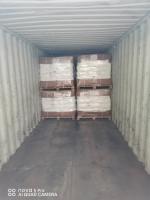Our Products
Polyacrylamide / cationic polyacrylamide emulsion Parestol K233 L can be replaced by Chinafloc EM4008

PRAESTOL K 233 is a high-performance cationic polyacrylamide emulsion, manufactured by Solenis (formerly Ashland and Stockhausen). It is formulated to contain active polymer content in the form of an oil-in-water emulsion and offers excellent solubility, fast floc formation, and high cationic charge density. The product is designed for sludge treatment, effluent clarification, and solid-liquid separation in both municipal and industrial wastewater systems.
The main characteristic of PRAESTOL K 233 is its medium to high molecular weight and strong cationic charge (often between 30–50%), which make it suitable for binding to negatively charged colloidal particles such as clay, organic matter, or biomass.
Sludge Dewatering: The Primary Application
What Is Sludge Dewatering?
Sludge dewatering refers to the process of removing as much water as possible from sludge—a semi-solid byproduct generated during wastewater treatment. The goal is to reduce the volume and weight of sludge to minimize the cost of transport, disposal, and further processing. Efficient sludge dewatering is vital for environmental compliance and cost-effective operation of treatment plants.
PRAESTOL K 233 is commonly applied just before mechanical dewatering equipment such as:
-
Belt Filter Presses
-
Screw Presses
-
Centrifuges
-
Chamber Filter Presses
-
Rotary Presses
By promoting flocculation, it creates a stronger, more compact sludge structure with better drainage characteristics. This results in drier sludge cakes and reduced disposal costs.
Mechanism of Action in Sludge Dewatering
PRAESTOL K 233 operates based on charge neutralization and bridging mechanisms:
-
Charge Neutralization:
The cationic groups in the polymer neutralize the negative charges on the surface of suspended solids in sludge. This reduces electrostatic repulsion between particles, allowing them to come closer together. -
Bridging:
The long-chain polymer molecules physically link multiple particles together, forming larger, more stable flocs. These larger flocs settle more quickly and can be more easily separated from the water.
The emulsion form ensures that PRAESTOL K 233 can be rapidly hydrated and activated in water, which shortens the response time in operational settings. This is crucial for continuous processes like municipal wastewater treatment.
Advantages of PRAESTOL K 233 in Dewatering
-
High Water Removal Efficiency: Produces drier sludge cake with lower moisture content.
-
Reduces Chemical Usage: Lowers the demand for other coagulants like ferric chloride or alum.
-
Fast-Acting: Emulsion form ensures fast dissolution and floc formation.
-
Cost-Saving: Reduces energy and disposal costs by minimizing sludge volume.
-
Environmental Compliance: Helps plants meet strict discharge and handling regulations.
Other Applications in Wastewater Treatment
Though sludge dewatering is the main application, PRAESTOL K 233 is also used in other areas of municipal and industrial wastewater treatment, including:
1. Primary and Secondary Clarification
-
Helps in sedimentation tanks to improve the settling of suspended solids.
-
Enhances the efficiency of primary and secondary clarifiers.
2. Thickening of Waste Activated Sludge (WAS)
-
Used in gravity belt thickeners or dissolved air flotation (DAF) units.
-
Increases the solids content of sludge before dewatering or digestion.
3. DAF Systems
-
Promotes flotation by increasing floc size and buoyancy.
-
Common in food processing and chemical industries for grease and oil removal.
4. Paper and Pulp Industry
-
Used to treat effluent streams by removing fiber, filler, and other suspended materials.
-
Improves clarity of recycled water and reduces freshwater consumption.
5. Mining and Mineral Processing
-
Aids in the separation of fine solids from mining slurry water.
-
Used for tailings dewatering and water recycling.
Recommended Usage
-
Dosage: Typical dosing ranges from 0.5 to 5 kg per dry ton of sludge, but optimization is necessary through jar testing.
-
Preparation: The emulsion must be diluted (usually to 0.1–0.5% concentration) and allowed to activate before application.
-
Handling: As an emulsion, PRAESTOL K 233 should be stored in well-ventilated areas and mixed gently to prevent separation.
Key Considerations in Application
To get optimal results from PRAESTOL K 233 in sludge dewatering or any other application, the following factors should be considered:
-
Sludge Characteristics: Organic/inorganic content, pH, temperature, and initial solids content can impact performance.
-
Polymer Make-up Water Quality: Use clean, chlorine-free water for preparing the solution.
-
Mixing and Maturation: Allow the emulsion to mature for 20–30 minutes after dilution to ensure full activation.
-
Feed Strategy: Apply the polymer just before dewatering equipment using precise metering pumps.
Environmental and Safety Aspects
-
Biodegradability: Cationic polyacrylamides like PRAESTOL K 233 are not inherently biodegradable but are stable and non-toxic at typical usage levels.
-
Safety: Though generally considered safe, spills should be cleaned immediately as they can make surfaces extremely slippery.
-
Disposal: Residual polymer should be treated according to local regulations for industrial chemicals.
Conclusion
In summary, the main application of cationic polyacrylamide emulsion (PRAESTOL K 233) is in sludge dewatering within wastewater treatment processes. Its strong cationic charge, high molecular weight, and emulsion formulation make it ideal for promoting effective solid-liquid separation, thereby reducing sludge volume and disposal costs. Beyond dewatering, it finds secondary applications in effluent clarification, DAF systems, and industrial water recycling, particularly in sectors such as municipal sewage treatment, food processing, pulp and paper, and chemical manufacturing. Its performance, ease of use, and cost-effectiveness make it an essential component of modern wastewater treatment operations.




294_small.jpg)
